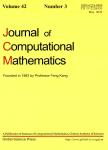ONE-PARAMETER FINITE DIFFERENCE METHODS AND THEIR ACCELERATED SCHEMES FOR SPACE-FRACTIONAL SINE-GORDON EQUATIONS WITH DISTRIBUTED DELAY
作者机构:School of Mathematics and StatisticsHuazhong University of Science and TechnologyWuhan 430074China Hubei Key Laboratory of Engineering Modeling and Scientific ComputingHuazhong University of Science and TechnologyWuhan 430074China Department of MathematicsUniversity of MacaoMacaoChina
出 版 物:《Journal of Computational Mathematics》 (计算数学(英文))
年 卷 期:2024年第42卷第3期
页 面:705-734页
核心收录:
基 金:supported by the NSFC(Grant No.11971010) the Science and Technology Development Fund of Macao(Grant No.0122/2020/A3) MYRG2020-00224-FST from University of Macao,China.
主 题:Fractional sine-Gordon equation with distributed delay One-parameter finite difference methods Convergence analysis ADI scheme PCG method
摘 要:This paper deals with numerical methods for solving one-dimensional(1D)and twodimensional(2D)initial-boundary value problems(IBVPs)of space-fractional sine-Gordon equations(SGEs)with distributed delay.For 1D problems,we construct a kind of oneparameter finite difference(OPFD)method.It is shown that,under a suitable condition,the proposed method is convergent with second order accuracy both in time and space.In implementation,the preconditioned conjugate gradient(PCG)method with the Strang circulant preconditioner is carried out to improve the computational efficiency of the OPFD method.For 2D problems,we develop another kind of OPFD method.For such a method,two classes of accelerated schemes are suggested,one is alternative direction implicit(ADI)scheme and the other is ADI-PCG scheme.In particular,we prove that ADI scheme can arrive at second-order accuracy in time and space.With some numerical experiments,the computational effectiveness and accuracy of the methods are further verified.Moreover,for the suggested methods,a numerical comparison in computational efficiency is presented.



